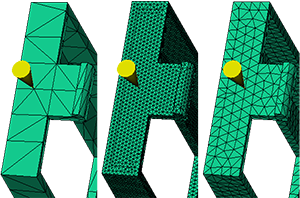After generating or modifying the mesh, it is advisable to perform a series of diagnostic checks to ensure that the mesh is suitable for analysis.
- Mesh Statistics
- Mesh Repair Wizard
- Mesh Diagnostics
- Element aspect ratios ideally should be below the following limits:
- 20:1 for triangular elements in Midplane and Dual Domain meshes.
- 30:1 for triangular elements in a Dual Domain mesh that will be converted to a 3D mesh.
- 50:1 for tetrahedral elements in a 3D mesh.
- In a Dual Domain model, we recommend to keep the mesh match ratio above 85% for flow analysis, and above 90% for warpage analysis.
- In Midplane and Dual Domain models, significant thickness changes must be represented with at least three rows of elements to ensure accurate prediction of flow issues such as hesitation or racetracking.
Optionally, you can remove small features like fillets and radii from Midplane and Dual Domain models to reduce the computing time. These features can be analyzed in 3D models, with a very high mesh density and little overall change in the results - as there is additional computational time required, removing the fine in these areas can often be justified.
A good mesh is critical for accurate results. The recommendations below will help you to evaluate and adjust the mesh as required.
Visual Inspection

Visual inspection of a Dual Domain mesh
- The first mesh is a too coarse (has few elements), and this mesh may not represent part thickness changes well.
- The second mesh has many more elements than necessary; this will result in a long computing time with limited increase in accuracy.
- The third example has a good mesh density. There are several rows of elements on the side, and the elements are approximately equilateral triangles, which indicates acceptable aspect ratios have been achieved.
Mesh Statistics
Once the visual inspection has determined the mesh density looks right, use the Mesh Statistics report to determine if the quality of the mesh is acceptable.
- Entity counts.
- Edge details.
- Orientation details.
- Intersection details.
- Surface triangle aspect ratio.
- Match percentage (Dual Domain models only).
- Nodes (Number).
- Elements (Tetras: Number, Volume, Aspect ratio, Maximum dihedral angle; and Beams: Number, Volume).
- Total volume.
Once a problem has been identified in the mesh statistics, corrective action can be taken to fix the problem.